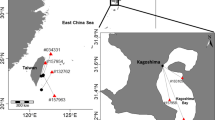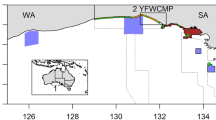Abstract
Cownose ray, Rhinoptera bonasus, is a common elasmobranch species along the southeast United States coast that recently has received negative attention. These rays can consume considerable amounts of commercial shellfish raising concerns regarding their control and need for effective management. However, limited information is known regarding their population abundance and migration patterns. We addressed the latter by reviewing 25 tagged cownose rays in Chesapeake Bay with pop-up satellite archival tags (PSATs) to study their movement patterns during summer and fall and identify wintering grounds. Eleven tags provided useful data on temperature, depth, light level and/or end locations. The migration tracks were deciphered through geolocation based on light levels, sea surface temperatures and depth constraints. PSAT end locations indicated southern wintering grounds in the coastal waters of central Florida. Female rays migrated out of Chesapeake Bay at the end of September to early October and continued their southerly migration to Florida. Male rays exited the bay in July and migrated northward based on their estimated movement tracks. The male rays appeared to have a second summer feeding ground off the coast of southern New England. In the fall, males migrated south from New England to the same wintering grounds as the females. No diel differences in habitat use were detected; however, males tended to occupy a wider depth and temperature range compared to females. Information on the movement patterns and habitat use for cownose rays will assist in determining more effective recreational and commercial management plans.






Similar content being viewed by others
References
Akaike H (1973) Information theory and an extension of the maximum likelihood principle. In: Petrova BN, Csaki F (eds) Proceedings of the 2nd international symposium on information theory. Publishing House of the Hungarian Academy of Sciences, Budapest, pp 268–281
Argos (2015) Argos user’s manual. Available: http://www.argos-system.org/manual/. Accessed 2015 February
Basson M, Bravington MV, Hartog JR, Patterson TA (2016) Experimentally derived likelihoods for light-based geolocation. Methods Ecol Evol 7:980–989
Bigelow HB, Schroeder WC (1953) Fishes of the western north Atlantic. Part 2: sawfishes, guitarfishes, skates, rays, and chimeroids. Memoir Sears Foundation for Marine Research, Yale University
Blaylock RA (1993) Distribution and abundance of cownose rays, Rhinoptera bonasus (Rhinopteridae), in lower Chesapeake Bay, Virginia. Estuaries 16:253–263
Clark M (2001) Are deepwater fisheries sustainable?- the example of orange roughy (Hoplostethus atlanticus) in New Zealand. Fish Res 51:123–135
Collins AB, Huepel MR, Hueter RE, Motta PJ (2007) Hard prey specialists or opportunistic generalists? An examination of the diet of the cownose ray, Rhinoptera bonasus. Mar Freshw Res 58:135–144
Collins AB, Huepel MR, Simpfendorfer CA (2008) Spatial distribution and long-term movement patterns of cownose rays Rhinoptera bonasus within an estuarine river. Estuar Coasts 31:1174–1183
Craig JK, Gillikin PC, Magelnicki MA, May LN (2010) Habitat use of cownose rays (Rhinoptera bonasus) in a highly productive, hypoxic continental shelf ecosystem. Fish Oceanogr 19:301–317
Fisher RA (2009) Regional workshop on cownose ray issues identifying research and extension needs (proceedings). VIMS Marine Resource Report 2009-6. VSG-09-06 http://web.vims.edu/GreyLit/VIMS/mrr09-06.pdf
Fisher RA (2010) Life history, trophic ecology & prey handling by cownose ray, Rhinoptera bonasus, from Chesapeake Bay. NOAA final report (NA07NMF4570324) Grant No. 713031. VIMS Marine Resource Report No. 2010-20, VSG-10-25
Fisher RA, Call GC, Grubbs RD (2011) Cownose ray (Rhinoptera bonasus) predation relative to bivalve ontogeny. J Shellfish Res 30:187–196
Fisher RA, Call GC, Grubbs RD (2013) Age, growth, and reproductive biology of cownose rays in Chesapeake Bay. Mar Coast Fish: Dyn Manage Ecosyst Sci 5:224–235
Fisher RA, Call GC, McDowell JM (2014) Reproductive variations in cownose rays (Rhinoptera bonasus) from Chesapeake Bay. Environ Biol Fish 97:1031–1038
Franke E, Bade L, Curtis T, Ferrier D, Fisher R, Grubbs R, Ihde T, McDowell J, Ogburn M, Townsend H (2016) Cownose rays in the Chesapeake Bay: what do we know? Workshop report. Chesapeake bay Program, sustainable fisheries goal implementation team. Annapolis pp 1-30. http://www.chesapeakebay.net/channel_files/23141/cnr_workshop_report_final_1-29-16.pdf
Galuardi B, Royer F, Golet W, Logan J, Neilson J, Lutcavage M (2010) Complex migration routes of Atlantic bluefin tuna (Thunnus thynnus) question current population structure paradigm. Can J Fish Aquat Sci 67:966–976
Garrison LP, Link JS (2000) Fishing effects on spatial distribution and trophic guild structure of the fish community in the Georges Bank region. ICES J Mar Sci 57:723–730
Goodman MA, Conn PB, Fitzpatrick E (2011) Seasonal occurrence of Cownose rays (Rhinoptera bonasus) in North Carolina’s estuarine and coastal waters. Estuar Coasts 34:640–651
Grubbs RD, Carlson JK, Romine JG, Curtis TH, McElroy WD, McCandless CT, Cotton CF, Musick JA (2016) Critical assessment and ramifications of a purported marine trophic cascade. Sci Rep 6:20970
Grusha DS (2005) Investigations into the life history of the Cownose ray, Rhinoptera bonasus, (Mitchill, 1815). Master’s thesis. Virginia Institute of Marine Science, College of William and Mary, Gloucester Point
Grusha DS, Patterson MR (2005) Quantification of drag and lift imiposed by pop-up satellite archival tags and estimation of the metabolic cost to cownose rays (Rhinoptera bonasus). Fish Bull 103:63–70
Harvey AC (1990) Forecasting, structural time series models, and the Kalman filter. Cambridge University Press, Cambridge
Hays GC, Bradshaw CJA, James MC, Lovell P, Sims DW (2007) Why do Argos satellite tags deployed on marine animals stop transmitting? J Exp Mar Biol Ecol 349:52–60
Hill RD (1994) Theory of geolocation by light levels. In Elephant Seals: Population Ecology, Behavior, and Physiology. In: Boeuf L, Burney J, Laws RM (eds) . University of California Press, Berkeley, pp 227–236
Hoenig JM, Gruber SH (1990) Life-history patterns in the elasmobranchs: implications for fisheries management. In: HL Pratt, SH Gruber, T Taniuchi (eds) Elasmobranchs as living resources: advances in the biology, ecology, systematics and the status of the fisheries. NOAA Technical Report 90:1–16. U.S. Dept. Comm., Washington, DC
Hoolihan JP (2005) Horizontal and vertical movements of sailfish (Istiophorus platypterus) in the Arabian gulf, determined by ultrasonic and pop-up satellite tagging. Mar Biol 146:1015–1029
Hoolihan JP, Luo J, Abascal FJ, Campana SE, De Metrio G, Dewar H et al (2011) Evaluating post-release behaviour modification in large pelagic fish deployed with pop-up satellite archival tags. ICES J Mar Sci: Journal du Conseil 68:880–889
Lam CH, Nielsen A, Sibert JR (2008) Improving light and temperature based geolocation by unscented Kalman filtering. Fish Res 91:15–25
Le Port A, Sippel T, Montgomery JC (2008) Observation of mesoscale movements in the short-tailed stingray, Dasyatis brevicaudata, from New Zealand using a novel PSAT tag attachment method. J Exp Mar Biol Ecol 359:110–117
Luckenbach MW, Coen LD, Ross PG Jr, Stephen JA (2005) Oyster reef habitat restoration: relationships between oyster abundance and community development based on two studies in Virginia and South Carolina. J Coast Res 40:64–78
McDowell JR, Fisher RA (2013) Discrimination of cownose ray, Rhinoptera bonasus, stocks based on microsatellite DNA markers. NOAA final report (NA11NMF4570215), VIMS Marine Resource Report No. 2013-8
McEachran JD, Fechhelm JD (1998) Fishes of the Gulf of Mexico, vol 1. University of Texas Press, Austin
Merriner JV, Smith JW (1979) A report to the oyster industry of Virginia on the biology and management of the Cownose ray (Rhinoptera bonasus, Mitchill) in lower Chesapeake Bay. Virginia Institute of Marine Science, Special report in applied marine science and ocean engineering 216, Gloucester point
Murray TJ, Hudson K (2015) Virginia shellfish aquaculture situation and outlook report: results of the 2014 Virginia shellfish aquaculture crop reporting survey. VIMS Marine Resource Report 2015-3. VSG-15-01
Musick JA (1999) Life in the slow lane: ecology and conservation of long-lived marine animals. Am Fish Soc Symp 23:1-10
Musyl MK, Brill RW, Curran DS, Gunn JS, Hartog JR, Hill RD et al (2001) Ability of archival tags to provide estimates of geographical position based on light intensity. In: Sibert J, Nielsen J (eds) Electronic tagging and tracking in marine fisheries reviews: methods and technology in fish and biology and fisheries. Kluwer, Dordrecht, pp 343–367
Musyl MK, Moyes CD, Brill RW, Fragoso NM (2009) Factors influencing mortality estimates in post-release survival studies. Mar Ecol Prog Ser 396:157–159
Musyl MK, Domeier ML, Nasby-Lucas N, Brill RW, McNaughton LM, Swimmer JY, Lutcavage MS, Wilson SG, Galuardi B, Liddle JB (2011) Performance of pop-up satellite archival tags. Mar Ecol-Prog Ser 433:1–28
Neer JA, Thompson BA (2005) Life history of the cownose ray, Rhinoptera bonasus, in the northern Gulf of Mexico, with comments on geographic variability in life history traits. Environ Biol Fish 73:321–331
Neer JA, Rose KA, Cortes E (2007) Simulating the effects of temperature on individual and population growth of Rhinoptera bonasus: a coupled bioenergetics and matrix modeling approach. Mar Ecol-Prog Ser 329:211–223
Paolisso M, Dery N, Herman S (2006) Restoration of the Chesapeake Bay using a non-native oyster: ecological and fishery considerations. Hum Organ 65:253–267
Peterson CH, Fodrie FJ, Summerson HC, Powers SP (2001) Site-specific and density-dependent extinction of prey by schooling rays: generation of a population sink in top-quality habitat for bay scallops. Oecologia 129:349–356
R Core Team (2012) R: A language and environment for statistical computing. R Foundation for Statistical Computing, Vienna, ISBN: 3–900051–08-9, URL: http://www.R-project.org/
Rogers C, Roden C, Lohoefener R, Mullin K, Hoggard W (1990) Behavior, distribution, and relative abundance of cownose ray schools Rhinoptera bonasus in the northern Gulf of Mexico. NE Gulf Sci 11:69–76
Schwartz FJ (1964) Effects of winter water conditions on fifteen species of captive marine fishes. Am Midl Nat 71:434–444
Sibert JR, Musyl MK, Brill RW (2003) Horizontal movements of bigeye tuna (Thunnus obesus) near Hawaii determined by Kalman filter analysis of archival tagging data. Fish Oceanogr 12:141–151
Smith JW, Merriner JV (1985) Food habits and feeding behavior of the Cownose ray, Rhinoptera bonasus, in lower Chesapeake Bay. Estuaries 8:305–310
Smith JW, Merriner JV (1986) Observations on the reproductive biology of the cownose ray, Rhinoptera bonasus, in Chesapeake Bay. U.S. NMFS Fish Bull 84:871–877
Smith JW, Merriner JV (1987) Age and growth, movements and distribution of the Cownose ray, Rhinoptera bonasus, in Chesapeake Bay. Estuaries 10:153–164
Swimmer Y, Arauz R, McCracken M, McNaughton L, Ballestero J, Musyl M et al (2006) Diving behavior and delayed mortality of olive ridely sea turtles Lepidochelys olivacea after their release from longline fishing gear. Mar Ecol-Prog Ser 323:253–261
Teo SL, Boustany AM, Block BA (2007) Oceanographic preferences of Atlantic bluefin tuna, Thunnus thynnus, on their Gulf of Mexico breeding grounds. Mar Biol 152:1105–1119
Acknowledgements
A special thanks to John Hoenig for providing partial funding for pop-up satellite archival tags and advice throughout the project. This study was made possible by haul seiner fishermen, John Dryden and George Trice, for their assistance with the collection of rays, and field support from the volunteers and students at the Virginia Institute of Marine Science. We thank Benjamin Galuardi from National Marine Fisheries Service and Heather Baer and other members at Wildlife Computers for their programming support. All work with the capture, holding, tagging and release of cownose rays was conducted under the guidelines of Institutional Animal Care and Use Committee (IACUC) protocols (IACUC-2012-07-09-8040-rafish). This research was carried out in part under the auspices of the Cooperative Institute for Marine and Atmospheric Studies, a cooperative institute of the University of Miami and the National Oceanic and Atmospheric Administration (cooperative agreement NA15OAR4320064), Virginia Marine Resources Commission (Award Number V774310) and equipment trust funds from College of William & Mary. This paper is Contribution No. 3654 of the Virginia Institute of Marine Science, College of William & Mary.
Author information
Authors and Affiliations
Corresponding author
Rights and permissions
About this article
Cite this article
Omori, K.L., Fisher, R.A. Summer and fall movement of cownose ray, Rhinoptera bonasus, along the east coast of United States observed with pop-up satellite tags. Environ Biol Fish 100, 1435–1449 (2017). https://doi.org/10.1007/s10641-017-0654-6
Received:
Accepted:
Published:
Issue Date:
DOI: https://doi.org/10.1007/s10641-017-0654-6




